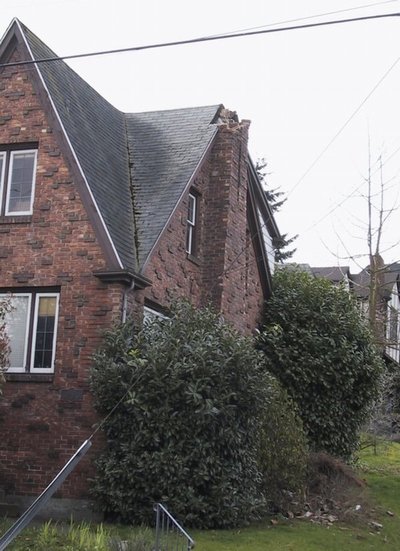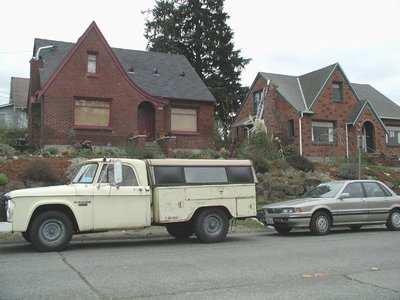June 22, 2004
Brick chimneys can double as strong-motion sensors in earthquakes
When the Nisqually earthquake struck western Washington in 2001, brick chimneys in parts of West Seattle and Bremerton were left looking like so much straw after the Big Bad Wolf had gone huffing and puffing through.
Hundreds of brick chimneys at the north end of West Seattle and north of Puget Sound Naval Shipyard in Bremerton were seriously damaged or toppled by the magnitude 6.7 temblor.
New research suggests the main culprit might have been the Seattle fault, even though the earthquake was centered 35 miles farther south, near Olympia, and 35 miles deep. The Seattle fault runs from the Kitsap Peninsula across Puget Sound and through southern Seattle, and continues into eastern King County.
The Seattle fault did not move during the earthquake. However, it appears one of its strands might have acted something like a megaphone, gathering the seismic waves and bending their energy toward the surface directly above, said Derek Booth, a University of Washington research associate professor of Earth and space sciences and of civil and environmental engineering.
Booth is the lead author of a paper examining patterns of damage to unreinforced brick chimneys following the earthquake on Feb. 28, 2001, damage comparable to what resulted from a similar western Washington earthquake in 1965. The paper appears in the June edition of the Bulletin of the Seismological Society of America. Co-authors are Ray Wells and Robert Givler of the U.S. Geological Survey in Menlo Park, Calif.
In the days immediately following the quake, the researchers surveyed 60,000 chimneys, block by block, over about 30 square miles. They identified 1,556 damaged chimneys and noted that damage was heavily clustered in certain areas, particularly at the north end of West Seattle and, to a lesser extent, in Bremerton’s residential neighborhoods just north of the naval shipyard.
They noted that the damage did not strongly correspond to the distance from the epicenter or the presence of soft soils, unusual topography or steep slopes.
Besides West Seattle and Bremerton, the researchers also surveyed chimney damage in a number of other Seattle neighborhoods, including Magnolia, Wallingford, Green Lake, Beacon Hill, Madrona and South Park. Damage in these areas was far less pronounced and more sporadic. Even a section of Madrona, the only other survey area atop a Seattle fault strand, didn’t have damage similar to West Seattle or Bremerton, but it is unclear why, Booth said.
A network of strong-motion sensors throughout the region has demonstrated that the areas with heavy chimney damage typically endured stronger shaking in the Nisqually quake.
“We already knew what the overall pattern of ground shaking was, and we wanted to see if the chimney data reflected that. It did,” Booth said. “What the chimneys also do, however, is provide a much greater spatial resolution than the instruments can. The instruments are separated by a half mile in a few places but more than three miles in other places, and if there are differences in shaking over a short distance the instruments will never pick that up because there just aren’t enough of them.”
In the case of West Seattle, strong shaking from the Nisqually earthquake was detected by a strong-motion detector at a fire station toward the north end of the neighborhood but much weaker shaking was recorded at a school about 1.5 miles farther south. The sensor data did not tell precisely where in between the intense shaking ceased, but the chimneys indicated the drop-off seemed to have occurred around Southwest Charlestown Street, about midway between the two sensors.
Booth noted that the evidence for the Seattle fault’s role in the strong ground shaking is still only circumstantial, but he added that the new research supports what has been suggested by previous studies from other areas of the country.
“West Seattle clearly has the strongest damage gradient. It’s pretty strong in Bremerton too, but the maximum damage there wasn’t as great,” he said.
“We believe they are genuinely reflecting differences in the strength of shaking and not the sudden replacement of good chimney contractors with bad contractors, or the sudden replacement of good mortar with bad mortar,” he said.
###
For more information, contact Booth at (206) 543-7923 or dbooth@u.washington.edu




